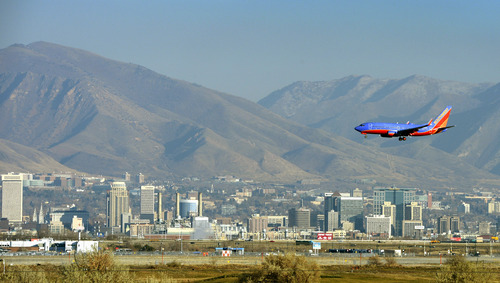This is an archived article that was published on sltrib.com in 2014, and information in the article may be outdated. It is provided only for personal research purposes and may not be reprinted.
The planned makeover of the Salt Lake City International Airport means big bucks — now and into the future.
It could provide the single most significant economic boost to Utah in the coming decade, according to one economist.
The mammoth eight-year, $1.8 billion construction project will pump $3.3 billion into the state's economy, according to a January 2013 analysis that takes into account that dollars are re-spent locally in what adds up to a multiplier effect.
The analysis by GSBS Richman Consulting notes the economic impact "includes funds spent directly by the airport and its tenants, wages and spending by airport suppliers and contractors, and wages spent by airport employees in the broader economy."
The construction project alone will account for 24,000 jobs, according to airport officials.
The existing airport has been a significant economic driver for Utah and its capital for the past 50 years and will continue to underpin the economy, according to analysts.
The current airport, the study shows, brings some $1.1 billion into the state's economy annually through its operations, capital investments, non-airline tenants and tourist and business visitor spending.
"The importance of the airport to Salt Lake City and Utah is enormous," Mayor Ralph Becker said. "The whole combination of ease and exposure to Salt Lake City from this airport makes a real difference. We can get to any place in the country quickly and conveniently."
Measuring the ongoing contribution of the new airport beyond its completion in 2022 is difficult. But many believe its importance economically will continue to soar.
The upgraded airport will attract more large aircraft and more national and international flights, said Natalie Gochnour, associate dean at the University of Utah's David Eccles School of Business and chief economist at the Salt Lake Chamber.
That greater accessibility will strengthen business and the tourist industry, she said.
"The airport expansion is among the most significant economic events that will occur in Utah over the next decade," Gochnour said. "The investment will create value in the economy and enlarge the state's collective wealth."
And, she pointed out, it will secure Salt Lake City as a hub for Delta Air Lines.
Airport and municipal officials agree that Delta's hub has been a boon for the city and the state. Designers for the planned remake of the airport worked closely with Delta to ensure the airline got what it wanted, according to Maureen Riley, executive director of the city's Department of Airports.
Delta is pleased with the plan for new efficiencies in the three-level terminal and its 72 gates that will be accompanied by a plethora of new amenities, said Holden Shannon, the airline's senior vice president for corporate strategy and real estate.
"This is the core of our Western flight service," he said. "The new airport will allow us to up-gage. It will be more suitable to larger planes."
Salt Lake City is a stable market for Delta, Shannon said. "We feel wanted here, and we plan to grow 8 percent over the next eight years."
About 60 percent of non-connecting travelers at Salt Lake City International are made up of visitors, according to the GSBS Richman analysis.
Business visitor spending from 2009 through 2015 will have a $6.8 billion impact on Utah's economy, according to the study. Tourist spending over that same period will account for an additional $11.8 billion.
"Although the economic contribution identified in this report is significant, it is only a portion of the overall economic benefit of airport operations," the analysis states. "A successful airport is a region's primary means of competing in a global economy through travel, provision of services and transport of high-value goods."
The Salt Lake City airport has been and will continue to be just that, said airport board member Mike Zuhl.
"The airport is a real economic driver. It's an important factor in bringing business to Utah and keeping it here," Zuhl said. "There is no question the new airport will keep us moving forward in a very competitive environment."
About the airport makeover
Price tag • $1.8 billion
Funding • Passenger user fees, car-rental fees and federal grants
Capacity • Up to 30 million passengers a year
Terminals • 1
Gates • 72
Efficiencies • Estimated 25 percent to 30 percent less energy use
Completion • Summer 2022



